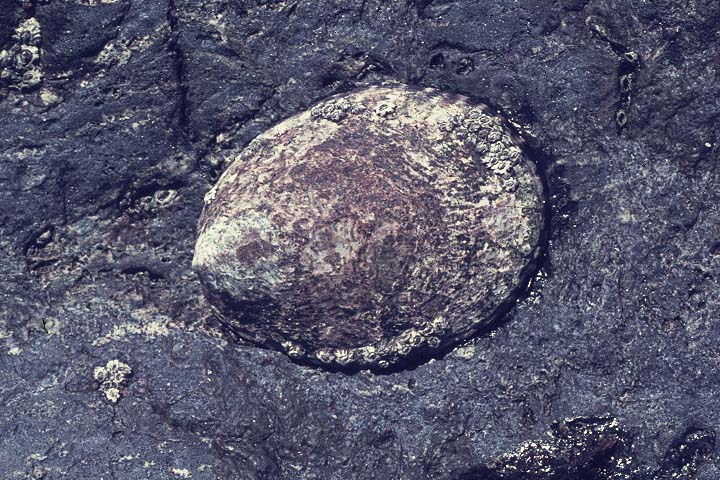

Back in the late 60's and early 70's, one of my biology classes at the Catalina Island School (Toyon) included a "survival hike." The intention was to have my students hike from Toyon to Little Harbor, gather their own food there, cook dinner and camp for the night before hiking back to school the next day. I wanted them to get in touch with the natural food resources available on the island. Were we ever to experience nuclear war or other large-scale social disaster, I wanted them to be able to live off the land. As preparation for this exercise, the students were supposed to study the food gathering of the native Americans on Catalina.
For my dinner I used to prepare an elaborate seafood stew. I gathered intertidal animals, mainly owl limpets, turban snails, and occasionally an abalone (although they were abundant then, I considered them too "easy" and besides, they were the less tasty black abalone). I'd cook them in a sea water broth with dethorned and cubed cactus pads and plant seeds as my veggies. I must admit my cooking today hasn't improved much. But these meals were sufficient until I could get back to the delightful dining hall food at Toyon! Owl limpets were fairly plentiful there in those days. Some approached three inches in length and they tasted almost like abalone (for those who remember that delicacy).
Like abalone, owl limpets are somewhat primitive molluscs in the snail (gastropod) category. They have a single, flattened shell to which the organism is attached. These shells seal to the rocks they live on and help prevent the animal inside from drying up during low tides. The shape of the shell allows strong waves to break over it easily so the limpet isn't torn loose from the rock. They hold on with the enlarged muscular foot that also allows them to move during periods of higher water. Surprisingly, these limpets do not grip the rock as tightly as might be expected, even in strong surf. Instead, they leave a small opening between the shell and rock which allows cilia to create a small water current. The current brings water in over the gills and also flushes wastes from the under the animal's shell.
This species of snail may be found from Neah Bay, Washington, to Baja California especially on rocky shores with fair surf exposure. Owl limpet reproduction was the subject of an early scientific study back in 1905. These snails breed in the fall and early winter. Large individuals (around 3") may be 10-15 years old. One thing I didn't realize 30+ years ago was that owl limpets are one of the species that change sex from male to female as they age. By collecting as many of the larger ones as I could for my stew, I was affecting the reproductive potential of the population. I should have been gathering more medium-sized limpets to keep a better sex ratio in the population... but by doing so I'd become a cross-species gender traitor!
Some individuals remain near "home scars" or slight depressions in the rocks throughout their lives, while others are more mobile. Both types are quite territorial though, living within a small area of about 1,000 cm2 (one square foot). Within this territory they will use their shells like a bulldozer to remove other limpets, mussels and even sea anemones. Their hard feeding structure, known as a radula, may also be used to scrape small barnacles away. An algal film soon develops within this cleared area and the owl limpets graze on it. Since they have removed the competition from other limpets and herbivores, they have this food source for themselves.
Our native peoples fed their communities with local resources including owl limpets which are common in their kitchen middens. I figured if they could survive year after year on this diet, my students could do so for 24 hours. Of course some packed food into camp and ate it in their sleeping bags under the cover of darkness. Others snuck into the Airport for a buffalo burger on their way back, and a few even hired a taxi or paid a passing vehicle for a lift all the way back to Toyon. So much for survival training! I guess this class wasn't much different from any of the others I taught there.
© 2004 Dr. Bill Bushing. Watch the "Dive Dry with Dr. Bill" underwater videos on Catalina Cable TV channel 49, 10:00 AM and 5:00 PM weekdays.

Owl limpet on the rocks at Toyon Bay.
This document maintained by
Dr. Bill Bushing.
Material
© 2004 Star Thrower Educational Multimedia